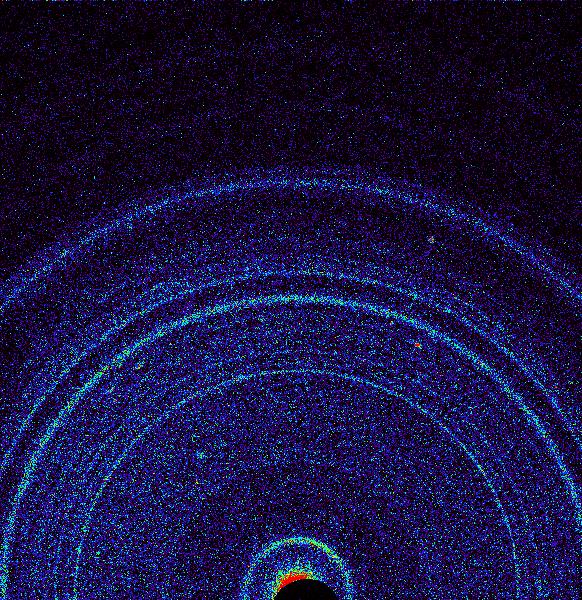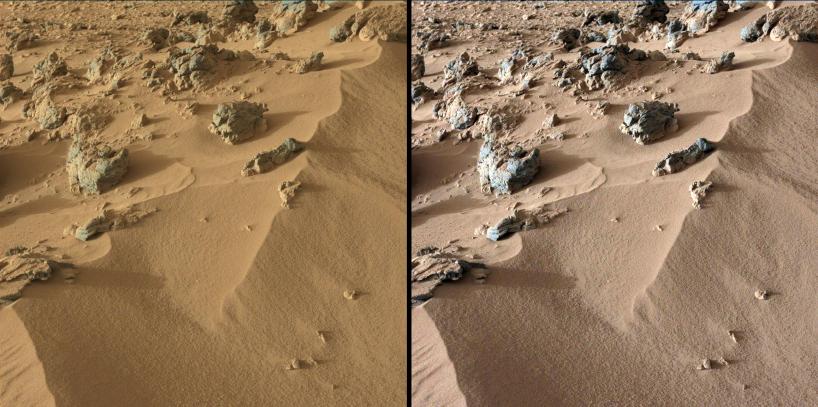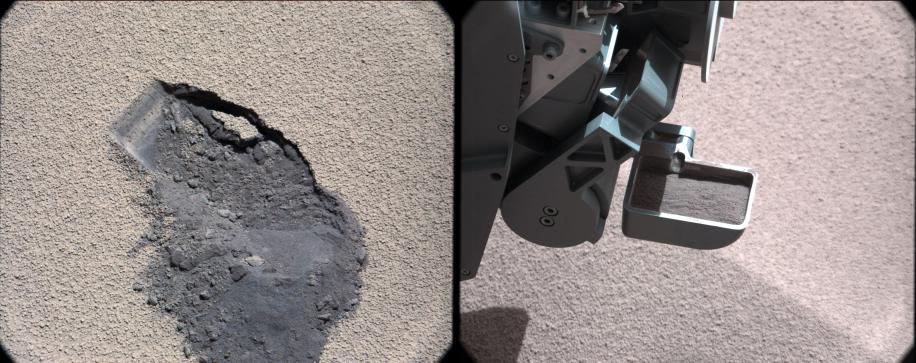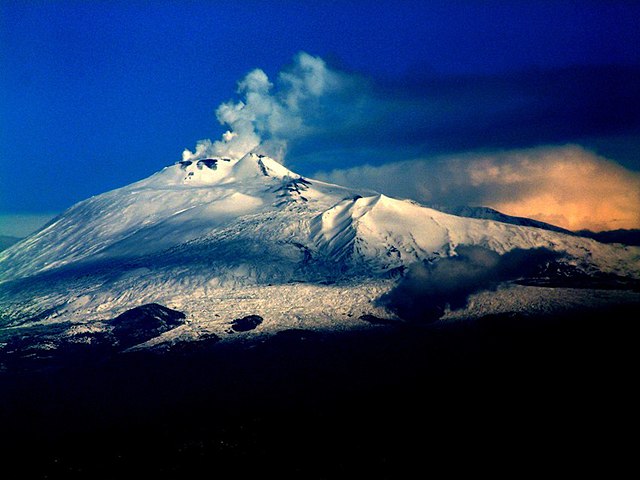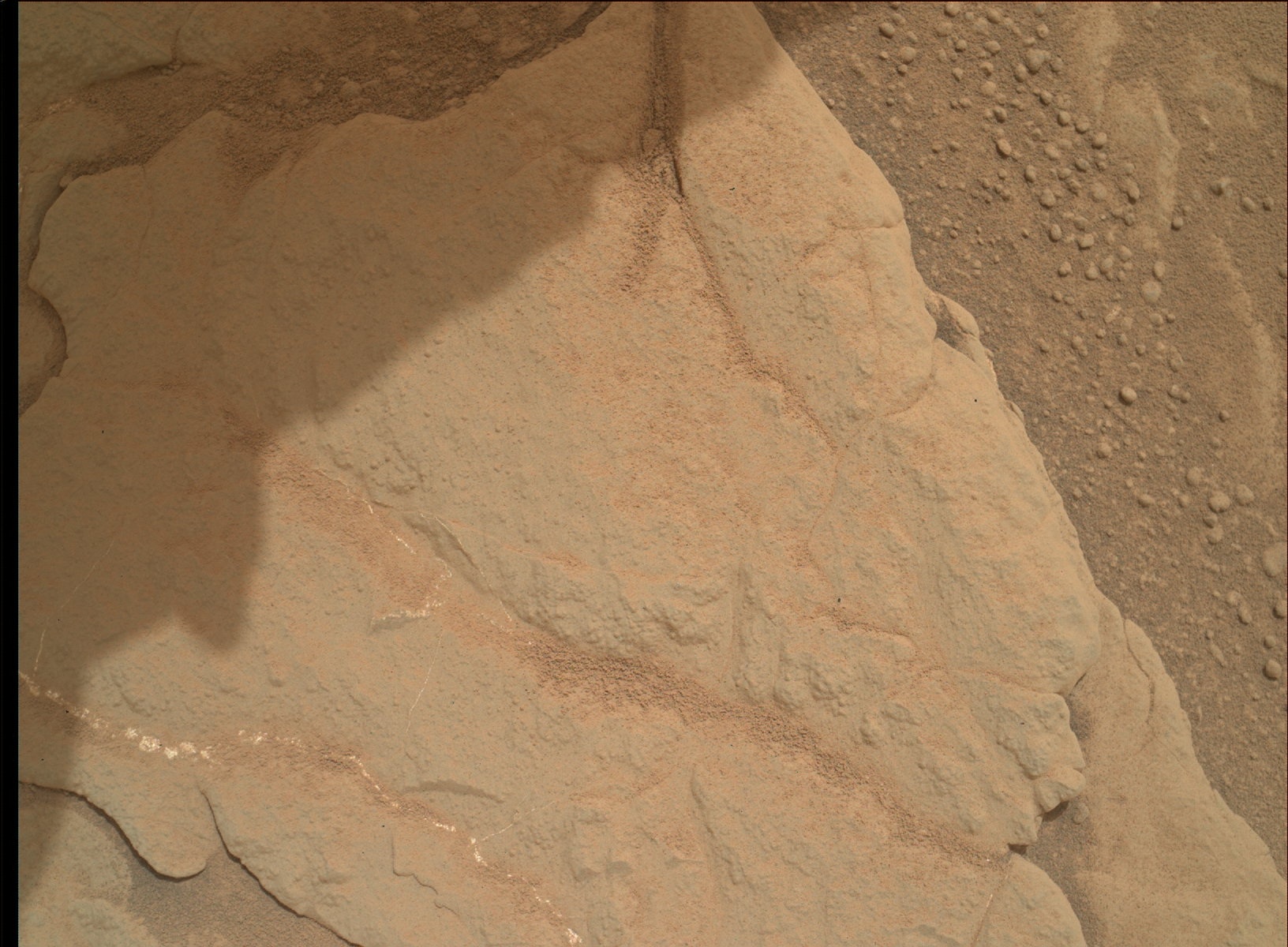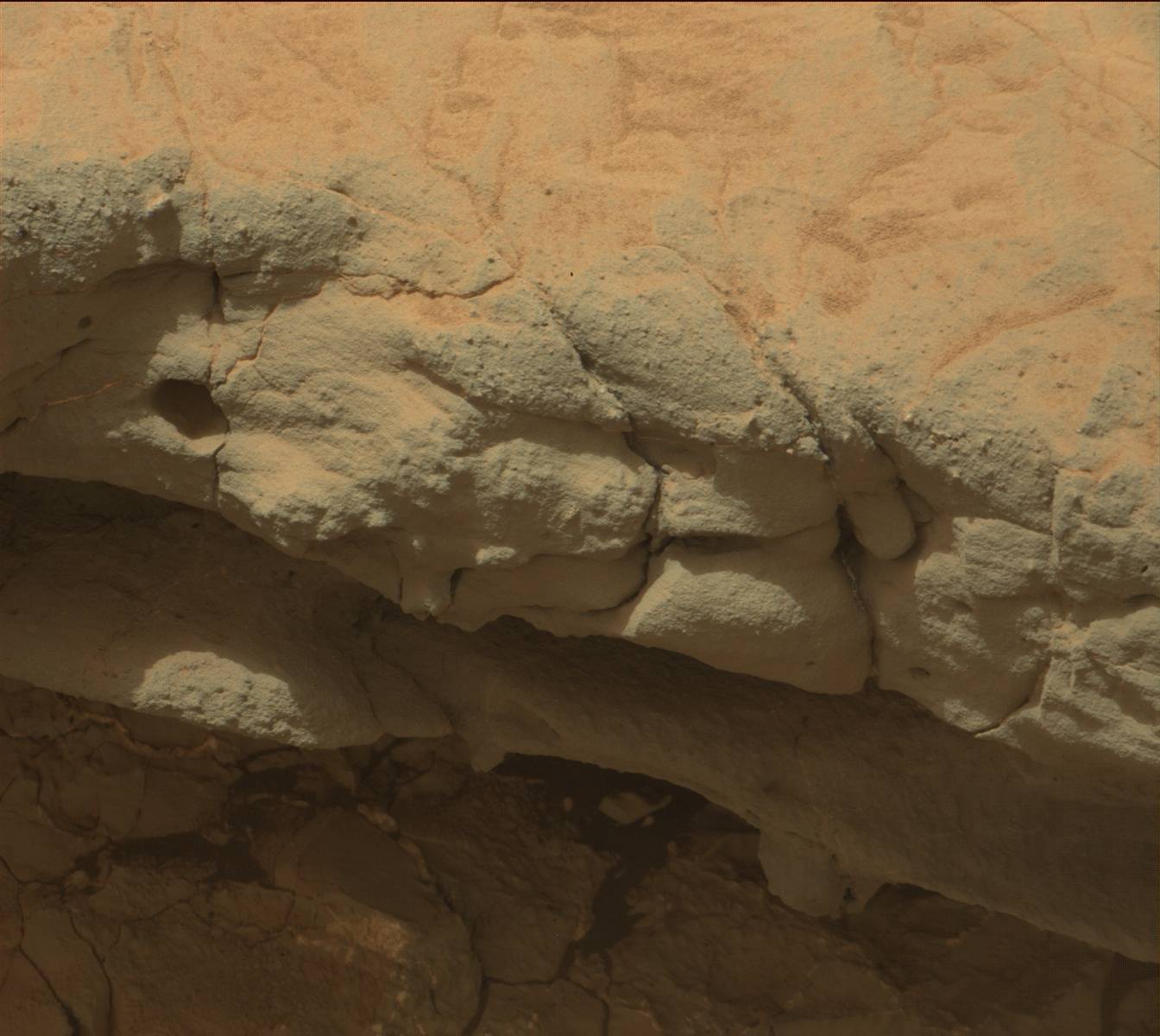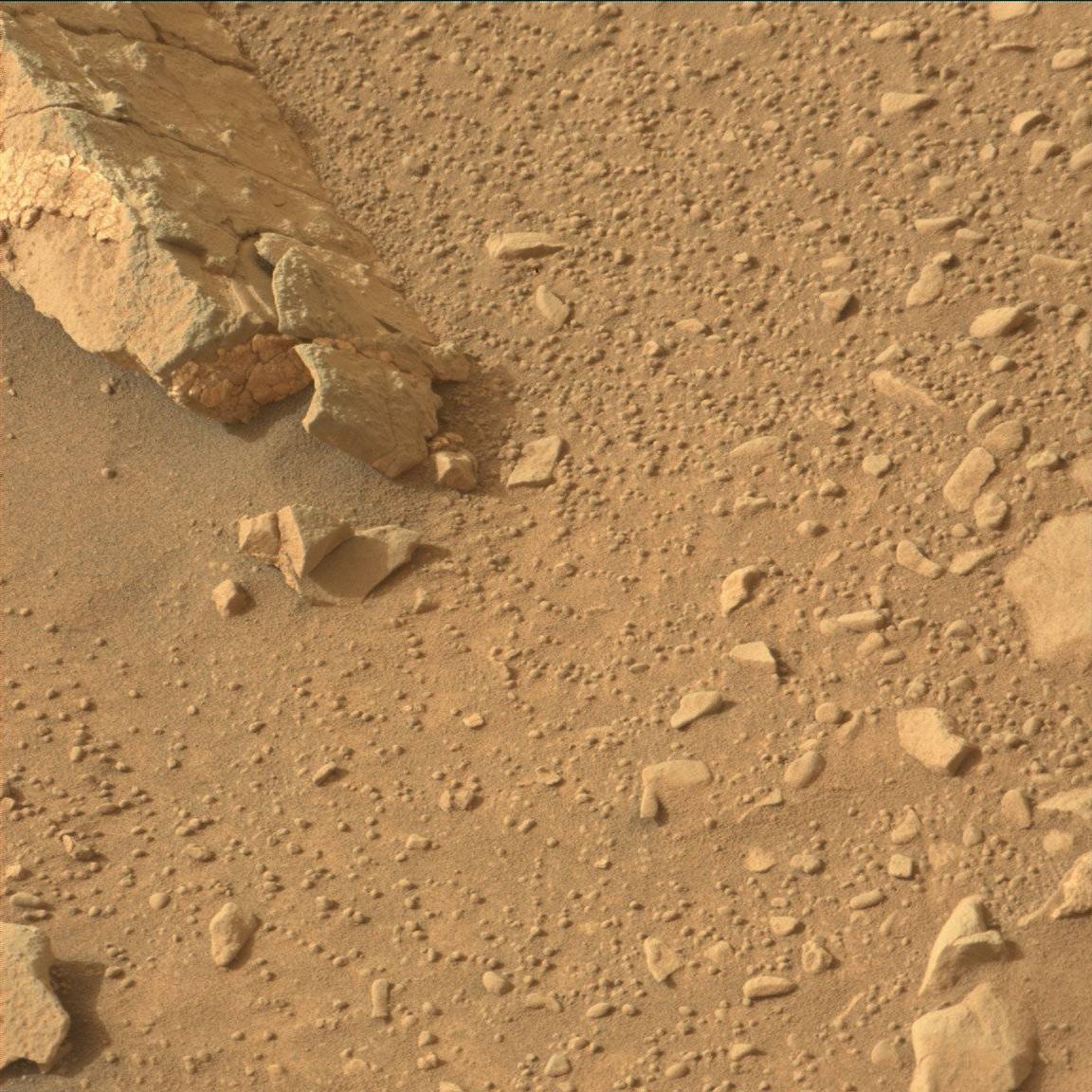Curiosity: Mars Science Laboratory
Re: No littering on Mars!
Know the quiet place within your heart and touch the rainbow of possibility; be
alive to the gentle breeze of communication, and please stop being such a jerk. — Garrison Keillor
alive to the gentle breeze of communication, and please stop being such a jerk. — Garrison Keillor
Re: No littering on Mars!
Finally  An opened Mars bar. There 'is' life on Mars after all.
An opened Mars bar. There 'is' life on Mars after all.
To find the Truth, you must go Beyond.
JPL: Curiosity Collects Fourth Scoop of Martian Soil
Curiosity Collects Fourth Scoop of Martian Soil
NASA JPL-Caltech | MSL Curiosity | 2012 Oct 22
NASA JPL-Caltech | MSL Curiosity | 2012 Oct 22
NASA's Mars rover Curiosity shook a scoopful of dusty sand inside its sample-handling mechanism on Sol 75 (Oct. 21, 2012) as the third scrubbing of interior surfaces of the mechanism. The rover team is instructing the rover to deliver a sieved sample from this scoopful -- the mission's fourth -- onto Curiosity's observation tray on Oct. 22 and plans to analyze another sample from the same scoopful with the Chemistry and Mineralogy (CheMin) instrument this week.
Curiosity collected this fourth scoop of soil on Sol 74 (Oct. 20). A later scoop will become the first delivered to the Sample Analysis at Mars (SAM) instrument. While continuing with scooping activities at the "Rocknest" site, the rover also has been examining surroundings with the Chemistry and Camera (ChemCam) and Mast Camera (Mastcam) instruments, and monitoring environmental conditions with the Radiation Assessment Detector (RAD), Rover Environmental Monitoring Station (REMS) and Dynamic Albedo of Neutrons (DAN) instruments of its science payload.
Sol 75, in Mars local mean solar time at Gale Crater, ended at 8:58 a.m. Oct. 22, PDT (11:58 a.m., EDT).
Know the quiet place within your heart and touch the rainbow of possibility; be
alive to the gentle breeze of communication, and please stop being such a jerk. — Garrison Keillor
alive to the gentle breeze of communication, and please stop being such a jerk. — Garrison Keillor
Curiosity Assessing Drop-Off to Observation Tray
Assessing Drop-Off to Mars Rover's Observation Tray
NASA JPL-Caltech | MSL Curiosity | 2012 Oct 25
NASA JPL-Caltech | MSL Curiosity | 2012 Oct 25
NASA's Mars rover Curiosity used its Mast Camera (Mastcam) during the mission's 78th sol (Oct. 24, 2012) to view soil material on the rover's observation tray. The observations will help assess movement of the sample on the tray in response to vibrations from sample-delivery and sample-processing activities of mechanisms on the rover's arm.
Curiosity is working with material from the fourth scoop of soil it collected at the "Rocknest" patch of dust and sand. On Sol 77, a sieved portion from this scoop was delivered to the Chemistry and Mineralogy (CheMin) instrument inside the rover. This is the second soil sample for CheMin analysis. The material from the fourth scoop is also being used to scrub internal surfaces of the rover's sample-processing mechanisms in preparation for delivery of a sample from a later scoop to the Sample Analysis at Mars (SAM) instrument.
Sol 78 activities included analysis of an atmosphere sample by SAM's Quadrupole Mass Spectrometer and monitoring of environmental conditions by the Rover Environmental Monitoring Station (REMS) and the Radiation Assessment Detector (RAD).
Sol 78, in Mars local mean solar time at Gale Crater, ended at 10:57 a.m. Oct. 25, PDT (1:57 p.m., EDT)
Know the quiet place within your heart and touch the rainbow of possibility; be
alive to the gentle breeze of communication, and please stop being such a jerk. — Garrison Keillor
alive to the gentle breeze of communication, and please stop being such a jerk. — Garrison Keillor
First Soil Studies Help Fingerprint Martian Minerals
First Soil Studies Help Fingerprint Martian Minerals
NASA | JPL-Caltech | MSL Curiosity | 2012 Oct 30
First Tastes of Martian Soil Offer Insights on Mineral Composition
Planetary Science Institute | 2012 Oct 30
Mars Rocks Similar to Some Found in Mexican Marshes
Alpha Galileo Foundation | Plataforma SINC | 2012 Oct 29
A Hint of Hawaii in the Sands of Mars
NASA Science News | Dr. Tony Phillips | 2012 Oct 31
NASA | JPL-Caltech | MSL Curiosity | 2012 Oct 30
NASA's Mars rover Curiosity has completed initial experiments showing the mineralogy of Martian soil is similar to weathered basaltic soils of volcanic origin in Hawaii.
The minerals were identified in the first sample of Martian soil ingested recently by the rover. Curiosity used its Chemistry and Mineralogy instrument (CheMin) to obtain the results, which are filling gaps and adding confidence to earlier estimates of the mineralogical makeup of the dust and fine soil widespread on the Red Planet.
"We had many previous inferences and discussions about the mineralogy of Martian soil," said David Blake of NASA Ames Research Center in Moffett Field, Calif., who is the principal investigator for CheMin. "Our quantitative results provide refined and in some cases new identifications of the minerals in this first X-ray diffraction analysis on Mars."
The identification of minerals in rocks and soil is crucial for the mission's goal to assess past environmental conditions. Each mineral records the conditions under which it formed. The chemical composition of a rock provides only ambiguous mineralogical information, as in the textbook example of the minerals diamond and graphite, which have the same chemical composition, but strikingly different structures and properties.
CheMin uses X-ray diffraction, the standard practice for geologists on Earth using much larger laboratory instruments. This method provides more accurate identifications of minerals than any method previously used on Mars. X-ray diffraction reads minerals' internal structure by recording how their crystals distinctively interact with X-rays. Innovations from Ames led to an X-ray diffraction instrument compact enough to fit inside the rover.
These NASA technological advances have resulted in other applications on Earth, including compact and portable X-ray diffraction equipment for oil and gas exploration, analysis of archaeological objects and screening of counterfeit pharmaceuticals, among other uses.
"Our team is elated with these first results from our instrument," said Blake. "They heighten our anticipation for future CheMin analyses in the months and miles ahead for Curiosity."
The specific sample for CheMin's first analysis was soil Curiosity scooped up at a patch of dust and sand that the team named Rocknest. The sample was processed through a sieve to exclude particles larger than 0.006 inch (150 micrometers), roughly the width of a human hair. The sample has at least two components: dust distributed globally in dust storms and fine sand originating more locally. Unlike conglomerate rocks Curiosity investigated a few weeks ago, which are several billion years old and indicative of flowing water, the soil material CheMin has analyzed is more representative of modern processes on Mars.
"Much of Mars is covered with dust, and we had an incomplete understanding of its mineralogy," said David Bish, CheMin co-investigator with Indiana University in Bloomington. "We now know it is mineralogically similar to basaltic material, with significant amounts of feldspar, pyroxene and olivine, which was not unexpected. Roughly half the soil is non-crystalline material, such as volcanic glass or products from weathering of the glass. "
Bish said, "So far, the materials Curiosity has analyzed are consistent with our initial ideas of the deposits in Gale Crater recording a transition through time from a wet to dry environment. The ancient rocks, such as the conglomerates, suggest flowing water, while the minerals in the younger soil are consistent with limited interaction with water."
First Tastes of Martian Soil Offer Insights on Mineral Composition
Planetary Science Institute | 2012 Oct 30
Mars Rocks Similar to Some Found in Mexican Marshes
Alpha Galileo Foundation | Plataforma SINC | 2012 Oct 29
A Hint of Hawaii in the Sands of Mars
NASA Science News | Dr. Tony Phillips | 2012 Oct 31
Know the quiet place within your heart and touch the rainbow of possibility; be
alive to the gentle breeze of communication, and please stop being such a jerk. — Garrison Keillor
alive to the gentle breeze of communication, and please stop being such a jerk. — Garrison Keillor
- neufer
- Vacationer at Tralfamadore
- Posts: 18805
- Joined: Mon Jan 21, 2008 1:57 pm
- Location: Alexandria, Virginia
Re: First Soil Studies Help Fingerprint Martian Minerals
bystander wrote:First Soil Studies Help Fingerprint Martian Minerals
NASA | JPL-Caltech | MSL Curiosity | 2012 Oct 30NASA's Mars rover Curiosity has completed initial experiments showing the mineralogy of Martian soil is similar to weathered basaltic soils of volcanic origin in Hawaii. The minerals were identified in the first sample of Martian soil ingested recently by the rover. Curiosity used its Chemistry and Mineralogy instrument (CheMin) to obtain the results, which are filling gaps and adding confidence to earlier estimates of the mineralogical makeup of the dust and fine soil widespread on the Red Planet. "We had many previous inferences and discussions about the mineralogy of Martian soil," said David Blake of NASA Ames Research Center in Moffett Field, Calif., who is the principal investigator for CheMin. "Our quantitative results provide refined and in some cases new identifications of the minerals in this first X-ray diffraction analysis on Mars."http://en.wikipedia.org/wiki/Volcanism_on_Mars#Differences_in_volcanic_styles_between_Earth_and_Mars wrote:
Differences in volcanic styles between Earth and Mars
<<The most common form of volcanism on the Earth is basaltic. Basalts are extrusive igneous rocks derived from the partial melting of the upper mantle. They are rich in iron and magnesium (mafic) minerals and commonly dark gray in color. The principal type of volcanism on Mars is almost certainly basaltic too. On Earth, basaltic magmas commonly erupt as highly fluid flows, which either emerge directly from vents or form by the coalescence of molten clots at the base of fire fountains (Hawaiian eruption). These styles are also common on Mars, but the lower gravity and atmospheric pressure on Mars allow nucleation of gas bubbles to occur more readily and at greater depths than on Earth. As a consequence, Martian basaltic volcanoes are also capable of erupting large quantities of ash in Plinian-style eruptions. In a Plinian eruption, hot ash is incorporated into the atmosphere, forming a huge convective column (cloud). If insufficient atmosphere is incorporated, the column may collapse to form pyroclastic flows. Plinian eruptions are rare in basaltic volcanoes on Earth where such eruptions are most commonly associated with silica-rich andesitic or rhyolitic magmas (e.g., Mount St. Helens).
Because the lower gravity of Mars generates less buoyancy forces on magma rising through the crust, the magma chambers that feed volcanoes on Mars are thought to be deeper and much larger than those on Earth. If a magma body on Mars is to reach close enough to the surface to erupt before solidifying, it must be big. Consequently, eruptions on Mars are less frequent than on Earth, but are of enormous scale and eruptive rate when they do occur. Somewhat paradoxically, the lower gravity of Mars also allows for longer and more widespread lava flows. Lava eruptions on Mars may be unimaginably huge. A vast lava flow the size of the state of Oregon has recently been described in western Elysium Planitia. The flow is believed to have been emplaced turbulently over the span of several weeks and thought to be one of the youngest lava flows on Mars.
The tectonic settings of volcanoes on Earth and Mars are very different. Most active volcanoes on Earth occur in long, linear chains along plate boundaries, either in zones where the lithosphere is spreading apart (divergent boundaries) or being subducted back into the mantle (convergent boundaries). Because Mars currently lacks plate tectonics, volcanoes there do not show the same global pattern as on Earth. Martian volcanoes are more analogous to terrestrial mid-plate volcanoes, such as those in the Hawaiian Islands, which are thought to have formed over a stationary mantle plume.
The largest and most conspicuous volcanoes on Mars occur in Tharsis and Elysium regions. These volcanoes are strikingly similar to shield volcanoes on Earth. Both have shallow-sloping flanks and summit calderas. The main difference between Martian shield volcanoes and those on Earth is in size: Martian shield volcanoes are truly colossal. For example, the tallest volcano on Mars, Olympus Mons, is 550 km across and 21 km high. It is nearly 100 times greater in volume than Mauna Loa in Hawaii, the largest shield volcano on Earth. Geologists think one of the reasons that volcanoes on Mars are able to grow so large is because Mars lacks plate tectonics. The Martian lithosphere does not slide over the upper mantle (asthenosphere) as on Earth, so lava from a stationary hot spot is able to accumulate at one location on the surface for a billion years or longer.>>
Art Neuendorffer
Curiosity Finds Clues to Changes in Martian Atmosphere
Curiosity Finds Clues to Changes in Martian Atmosphere
NASA | GSFC | JPL-Caltech | MSL Curiosity | 2012 Nov 02
Curiosity Finds Methane on Mars, or Not
Science NOW | Richard A. Kerr | 2012 Nov 02
Where's Mars' Methane? Curiosity Draws a Blank
Discovery News | Irene Klotz | 2012 Nov 02
http://asterisk.apod.com/viewtopic.php?t=29921
NASA | GSFC | JPL-Caltech | MSL Curiosity | 2012 Nov 02
NASA's car-sized rover, Curiosity, has taken significant steps toward understanding how Mars may have lost much of its original atmosphere.Click to play embedded YouTube video.Click to play embedded YouTube video.
Learning what happened to the Martian atmosphere will help scientists assess whether the planet ever was habitable. The present atmosphere of Mars is 100 times thinner than Earth's.
A set of instruments aboard the rover has ingested and analyzed samples of the atmosphere collected near the "Rocknest" site in Gale Crater where the rover is stopped for research. Findings from the Sample Analysis at Mars (SAM) instruments suggest that loss of a fraction of the atmosphere, resulting from a physical process favoring retention of heavier isotopes of certain elements, has been a significant factor in the evolution of the planet. Isotopes are variants of the same element with different atomic weights.
Initial SAM results show an increase of five percent in heavier isotopes of carbon in the atmospheric carbon dioxide compared to estimates of the isotopic ratios present when Mars formed. These enriched ratios of heavier isotopes to lighter ones suggest the top of the atmosphere may have been lost to interplanetary space. Losses at the top of the atmosphere would deplete lighter isotopes. Isotopes of argon also show enrichment of the heavy isotope, matching previous estimates of atmosphere composition derived from studies of Martian meteorites on Earth.
Scientists theorize that in Mars' distant past its environment may have been quite different, with persistent water and a thicker atmosphere. NASA's Mars Atmosphere and Volatile Evolution, or MAVEN, mission will investigate possible losses from the upper atmosphere when it arrives at Mars in 2014.
With these initial sniffs of Martian atmosphere, SAM also made the most sensitive measurements ever to search for methane gas on Mars. Preliminary results reveal little to no methane. Methane is of interest as a simple precursor chemical for life. On Earth, it can be produced by either biological or non-biological processes.
Methane has been difficult to detect from Earth or the current generation of Mars orbiters because the gas exists on Mars only in traces, if at all. The Tunable Laser Spectrometer (TLS) in SAM provides the first search conducted within the Martian atmosphere for this molecule. The initial SAM measurements place an upper limit of just a few parts methane per billion parts of Martian atmosphere, by volume, with enough uncertainty that the amount could be zero.
"Methane is clearly not an abundant gas at the Gale Crater site, if it is there at all. At this point in the mission we're just excited to be searching for it," said SAM TLS lead Chris Webster of NASA's Jet Propulsion Laboratory in Pasadena, Calif. "While we determine upper limits on low values, atmospheric variability in the Martian atmosphere could yet hold surprises for us."
In Curiosity's first three months on Mars, SAM has analyzed atmosphere samples with two laboratory methods. One is a mass spectrometer investigating the full range of atmospheric gases. The other, TLS, has focused on carbon dioxide and methane. During its two-year prime mission, the rover also will use an instrument called a gas chromatograph that separates and identifies gases. The instrument also will analyze samples of soil and rock, as well as more atmosphere samples.
"With these first atmospheric measurements we already can see the power of having a complex chemical laboratory like SAM on the surface of Mars," said SAM Principal Investigator Paul Mahaffy of NASA's Goddard Space Flight Center in Greenbelt, Md. "Both atmospheric and solid sample analyses are crucial for understanding Mars' habitability."
SAM is set to analyze its first solid sample in the coming weeks, beginning the search for organic compounds in the rocks and soils of Gale Crater. Analyzing water-bearing minerals and searching for and analyzing carbonates are high priorities for upcoming SAM solid sample analyses.
Curiosity Finds Methane on Mars, or Not
Science NOW | Richard A. Kerr | 2012 Nov 02
Where's Mars' Methane? Curiosity Draws a Blank
Discovery News | Irene Klotz | 2012 Nov 02
http://asterisk.apod.com/viewtopic.php?t=29921
Know the quiet place within your heart and touch the rainbow of possibility; be
alive to the gentle breeze of communication, and please stop being such a jerk. — Garrison Keillor
alive to the gentle breeze of communication, and please stop being such a jerk. — Garrison Keillor
- geckzilla
- Ocular Digitator
- Posts: 9180
- Joined: Wed Sep 12, 2007 12:42 pm
- Location: Modesto, CA
- Contact:
Re: Curiosity Finds Clues to Changes in Martian Atmosphere
KERNING!!!!bystander wrote:Click to play embedded YouTube video.
Just call me "geck" because "zilla" is like a last name.
-
dougettinger
- Curious Querier
- Posts: 632
- Joined: Wed Mar 17, 2010 5:55 pm
- Location: Pittsburgh, PA
Re: Curiosity: Mars Science Laboratory
Has NASA proposed the origin of the Jake Matijewic Rock? Did it fall from some low ledge? Was it carried to this location by water transport? Is the rock some fallen debris from a nearby impact?
Doug
Doug
Doug Ettinger
Pittsburgh, PA
Pittsburgh, PA
- neufer
- Vacationer at Tralfamadore
- Posts: 18805
- Joined: Mon Jan 21, 2008 1:57 pm
- Location: Alexandria, Virginia
Re: Curiosity: Mars Science Laboratory
Click to play embedded YouTube video.
Click to play embedded YouTube video.
Art Neuendorffer
Curiosity: what are these seemingly reflective areas?
I wonder what this seemingly reflective area between the large rocks is. Can anyone help?
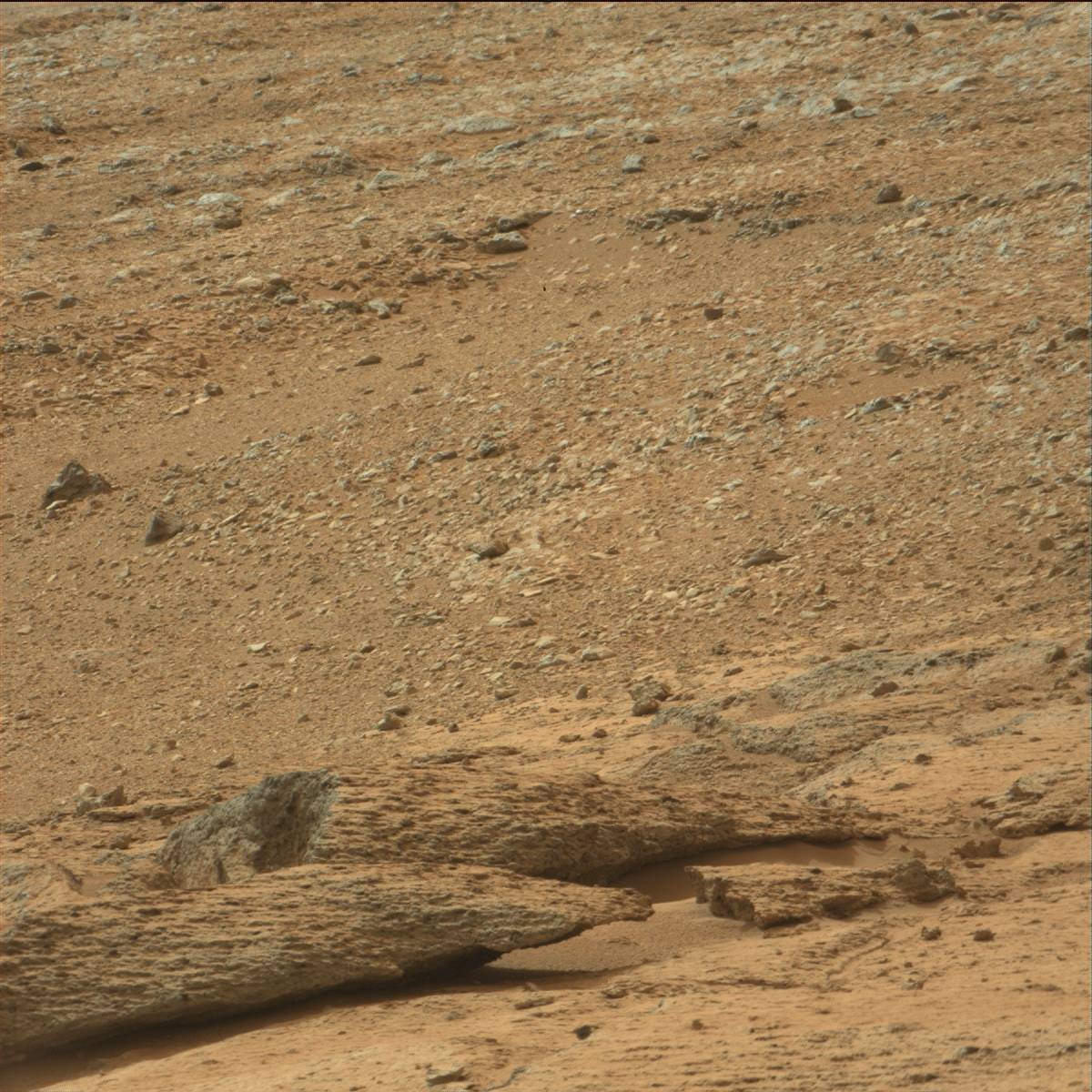
The original is here: http://mars.jpl.nasa.gov/msl-raw-images ... 1_DXXX.jpg
I collected more of them here:
http://marsweirdness.blogspot.nl/2012/1 ... areas.html

The original is here: http://mars.jpl.nasa.gov/msl-raw-images ... 1_DXXX.jpg
I collected more of them here:
http://marsweirdness.blogspot.nl/2012/1 ... areas.html
- Chris Peterson
- Abominable Snowman
- Posts: 18597
- Joined: Wed Jan 31, 2007 11:13 pm
- Location: Guffey, Colorado, USA
- Contact:
Re: Curiosity: what are these seemingly reflective areas?
I don't see anything reflective at all. Just some brighter material. Are you suggesting there are specular surfaces?daank wrote:I wonder what this seemingly reflective area between the large rocks is. Can anyone help?
Chris
*****************************************
Chris L Peterson
Cloudbait Observatory
https://www.cloudbait.com
*****************************************
Chris L Peterson
Cloudbait Observatory
https://www.cloudbait.com
- geckzilla
- Ocular Digitator
- Posts: 9180
- Joined: Wed Sep 12, 2007 12:42 pm
- Location: Modesto, CA
- Contact:
Re: Curiosity: what are these seemingly reflective areas?
His second link has images with lines pointing specifically to what he's referring to. The do look somewhat like small pools of water. I'm more inclined to think they are shadows on slanted sand surface, though.
Just call me "geck" because "zilla" is like a last name.
- Chris Peterson
- Abominable Snowman
- Posts: 18597
- Joined: Wed Jan 31, 2007 11:13 pm
- Location: Guffey, Colorado, USA
- Contact:
Re: Curiosity: what are these seemingly reflective areas?
Yes, I looked at the marked images. Those are the ones that show nothing that appears specular to me- just varying intensities from different materials and from shadows.geckzilla wrote:His second link has images with lines pointing specifically to what he's referring to. The do look somewhat like small pools of water. I'm more inclined to think they are shadows on slanted sand surface, though.
Chris
*****************************************
Chris L Peterson
Cloudbait Observatory
https://www.cloudbait.com
*****************************************
Chris L Peterson
Cloudbait Observatory
https://www.cloudbait.com
- rstevenson
- Quis custodiet ipsos custodes?
- Posts: 2705
- Joined: Fri Mar 28, 2008 1:24 pm
- Location: Halifax, NS, Canada
Re: Curiosity: what are these seemingly reflective areas?
I had a close look at those pictures too. The areas he points out just look like shadows that have a little extra light bouncing into them from nearby sandy areas that happen to be in the sun.
Rob
Rob
- geckzilla
- Ocular Digitator
- Posts: 9180
- Joined: Wed Sep 12, 2007 12:42 pm
- Location: Modesto, CA
- Contact:
Re: Curiosity: what are these seemingly reflective areas?
Well, yeah, but looking at it you could see how one's eye might be fooled into thinking it's looking at a reflection instead of a shadow. The "reflections" aren't very accurately reflecting the rocks above them, though.
Just call me "geck" because "zilla" is like a last name.
Re: Curiosity: what are these seemingly reflective areas?
Hi all, thanks for your replies 
I must admit you're most probably right, and my eyes fooled me, haha... However, I'm not completely certain of this.
I thought there might be some kind of liquid because:
1. It looks like it.
2. The surfaces are all in some kind of canals (I guess something may have been flowing there once)
3. The rocks near the surfaces all seem to have eroded: more near the bottom than at the top, like something has been flowing there.
4. On other images, like this one from sol 110, the seemingly reflective surfaces are completely lacking, and you can clearly see what plain sand looks like: it has more texture.
I've been trying to find more clues.
Like: the shadows in this image are pointing left to right (see the rock on the left), while the "shadows" in the areas I'm referring to are clearly top to bottom. But I'm not too sure about that.
And: there seems to be a "riple" in the presumed liquid on this picture making the pond-effect even more dramatic. However, on the image which was taken a 24 seconds before this one, the riple is exactly the same: sand.
So... for now have to agree with you.
At this moment, I'm also wondering, what are these two giant pinnacles that seem to have broken off from something and which have a weird texture. Does any of you know? Link: http://mars.jpl.nasa.gov/msl-raw-images ... 1_DXXX.jpg
Thanks
I must admit you're most probably right, and my eyes fooled me, haha... However, I'm not completely certain of this.
I thought there might be some kind of liquid because:
1. It looks like it.
2. The surfaces are all in some kind of canals (I guess something may have been flowing there once)
3. The rocks near the surfaces all seem to have eroded: more near the bottom than at the top, like something has been flowing there.
4. On other images, like this one from sol 110, the seemingly reflective surfaces are completely lacking, and you can clearly see what plain sand looks like: it has more texture.
I've been trying to find more clues.
Like: the shadows in this image are pointing left to right (see the rock on the left), while the "shadows" in the areas I'm referring to are clearly top to bottom. But I'm not too sure about that.
And: there seems to be a "riple" in the presumed liquid on this picture making the pond-effect even more dramatic. However, on the image which was taken a 24 seconds before this one, the riple is exactly the same: sand.
So... for now have to agree with you.
At this moment, I'm also wondering, what are these two giant pinnacles that seem to have broken off from something and which have a weird texture. Does any of you know? Link: http://mars.jpl.nasa.gov/msl-raw-images ... 1_DXXX.jpg
Thanks
Curosity day 129
http://mars.jpl.nasa.gov/msl/multimedia ... DXXX&s=129
From day 129 on Mars the MAHLI this images and some others show a patch of polygonal rock formations that have white striations in the cracks. Could this whiteness be Ice between the cracks?
From day 129 on Mars the MAHLI this images and some others show a patch of polygonal rock formations that have white striations in the cracks. Could this whiteness be Ice between the cracks?
- rstevenson
- Quis custodiet ipsos custodes?
- Posts: 2705
- Joined: Fri Mar 28, 2008 1:24 pm
- Location: Halifax, NS, Canada
Re: Curosity day 129
Fascinating images!
I've made a crop of the left part of the first of them, because there's an interesting variation in level happening there. I enhanced the brightness, contrast and sharpness a little, to make it easier to see detail. Here 'tis...
I think you can see that there is a difference in elevation when comparing the two smaller pieces of rock bottom-left to the larger amount of rock over the rest of the main image, top-right in my crop. The "mortar" (for want of a better term) that separates the pieces of rock remains sharp-edged and distinct, and attached to the rock top-right. I conclude then that the two rocks bottom-left have subsided, since I don't think the "mortar" would have remained so undisturbed if the rock top-right had risen.
I don't think this "mortar" would remain sharp edged for very long (in geologic terms), so we could conclude this subsidence happened fairly recently (in geologic terms). It could have happened because ice melted/sublimated out from under the rocks, or because fine sand eroded out from under them, or simply from general settling of an area of harder rock over looser material. All this could have happened so long ago that the "mortar" is as hard as any sedimentary rock here on Earth, in which case its apparent hard edged solidity wouldn't be very surprising.
Now if only there was a geologist there to lift one of them up and have a look under it.
Rob
I've made a crop of the left part of the first of them, because there's an interesting variation in level happening there. I enhanced the brightness, contrast and sharpness a little, to make it easier to see detail. Here 'tis...
I think you can see that there is a difference in elevation when comparing the two smaller pieces of rock bottom-left to the larger amount of rock over the rest of the main image, top-right in my crop. The "mortar" (for want of a better term) that separates the pieces of rock remains sharp-edged and distinct, and attached to the rock top-right. I conclude then that the two rocks bottom-left have subsided, since I don't think the "mortar" would have remained so undisturbed if the rock top-right had risen.
I don't think this "mortar" would remain sharp edged for very long (in geologic terms), so we could conclude this subsidence happened fairly recently (in geologic terms). It could have happened because ice melted/sublimated out from under the rocks, or because fine sand eroded out from under them, or simply from general settling of an area of harder rock over looser material. All this could have happened so long ago that the "mortar" is as hard as any sedimentary rock here on Earth, in which case its apparent hard edged solidity wouldn't be very surprising.
Now if only there was a geologist there to lift one of them up and have a look under it.
Rob
-
Guestation
Re: Curiosity: what are these seemingly reflective areas?
Yes, shadows on slanted surface; but how about those petrified, sandblasted logs!
Curosity day 132
Here is an interesting close-up image of a rock from day 132 via the MAHLI cam
Note in the larger view in the lower left corner there appears to be a crystalline structure protruding from the surface. Could this be a Martian Diamond?
Note in the larger view in the lower left corner there appears to be a crystalline structure protruding from the surface. Could this be a Martian Diamond?
- neufer
- Vacationer at Tralfamadore
- Posts: 18805
- Joined: Mon Jan 21, 2008 1:57 pm
- Location: Alexandria, Virginia
Sulfates?
http://www.jpl.nasa.gov/news/news.php?release=2007-029 wrote:[img3="While driving eastward toward the northwestern flank of "McCool Hill," the wheels of NASA's Mars Exploration Rover Spirit churned up the largest amount of bright soil discovered so far in the mission. This image, taken on the rover's 788th Martian day, or sol, of exploration (March 22, 2006), shows the strikingly bright tone and large extent of the materials uncovered. Image credit: NASA/JPL-Caltech/Cornell"]http://www.jpl.nasa.gov/images/mer/pia08039-browse.jpg[/img3]NASA Mars Rover Churns Up Questions With Sulfur-Rich Soil
March 14, 2007
<<Some bright Martian soil containing lots of sulfur and a trace of water intrigues researchers who are studying information provided by NASA's Spirit rover. "This material could have been left behind by water that dissolved these minerals underground, then came to the surface and evaporated, or it could be a volcanic deposit formed around ancient gas vents," said Dr. Ray Arvidson of Washington University, St. Louis. He is the deputy principal investigator for NASA's twin Mars rovers, Spirit and Opportunity.
Determining which of those two hypotheses is correct would strengthen understanding of the environmental history of the Columbia Hills region that Spirit has been exploring since a few months after landing on Mars in January 2004. However, investigating the bright soil presents a challenge for the rover team, because the loose material could entrap the rover.
The bright white and yellow material was hidden under a layer of normal-looking soil until Spirit's wheels churned it up while the rover was struggling to cross a patch of unexpectedly soft soil nearly a year ago. The right front wheel had stopped working a week earlier. Controllers at NASA's Jet Propulsion Laboratory, Pasadena, Calif., were trying to maneuver the rover backwards, dragging that wheel, to the north slope of a hill in order to spend the southern-hemisphere winter with solar panels tilted toward the sun.
Due to the difficulty crossing that patch, informally named "Tyrone," the team chose to drive Spirit to a smaller but more accessible slope for the winter. Spirit stayed put in its winter haven for nearly seven months. Tyrone was one of several targets Spirit examined from a distance during that period, using an infrared spectrometer to check their composition. The instrument detected small amounts of water bound to minerals in the soil.
The rover resumed driving in late 2006 when the Martian season brought sufficient daily sunshine to the solar panels. Some of the bright soil from Tyrone was dragged to the winter site by the right front wheel, and Spirit spent some time measuring the composition and mineralogy of these materials. The material is sulfur-rich and consists of sulfate salts associated with iron, and likely calcium. "These salts could have been concentrated by hydrothermal liquid or vapor moving through the local rocks," said rover science team member Dr. Albert Yen, a geochemist at JPL. Two other patches of bright soil uncovered by Spirit before Tyrone were also sulfur-rich, but each had similarities to local rock compositions that were different at the three sites, suggesting localized origins.
Researchers will watch for more patches of bright soil. "If we find them along fractures, that would suggest they were deposited at ancient gas vents," Arvidson said. "If they are at the saddles between hills, that would suggest the deposits formed where groundwater came to the surface." The layers consist of sulfate-rich sandstone similar to other bedrock Opportunity has been finding in Mars' Meridiani region for more than three years. The minerals come from a wet period in the region's ancient past. While exploring Victoria's rim with Opportunity, researchers have been on the lookout for rocks that might have been tossed out from layers deeper and older than the sulfates. "We found one group of cobbles that were clearly more resistant to erosion than the sulfate blocks thrown out onto the rim," Squyres said. "We checked the composition of one that we called Santa Catarina. Our suspicion now is that Santa Catarina is a piece of a meteorite." That would be the fifth meteorite found by the rovers.>>
Art Neuendorffer
Curosity day 133
Here are a couple of interesting day 133 images
This one shows some walling formations caused from either erosion
or collapse. I would place my money on Erosion though.
This one has an almost round hole in it. I wonder how deep it goes
and how close to round it really is
This one raises more questions about "What is that Mortar substance
between the cracks" there is an ample ammount on one of the surfaces
or collapse. I would place my money on Erosion though.
This one has an almost round hole in it. I wonder how deep it goes
and how close to round it really is
This one raises more questions about "What is that Mortar substance
between the cracks" there is an ample ammount on one of the surfaces
- THX1138
- Emailed Bob; Got a new title!
- Posts: 305
- Joined: Sat Nov 19, 2005 9:27 am
- AKA: Wile-e-coyote super genius
- Location: San Luis Obispo
- Contact:
Re: Curosity day 129
Cool pictures, sure wish we could go there real soon



